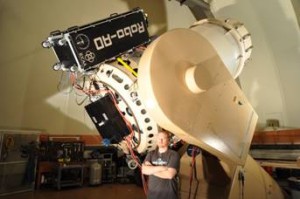Rise of the Machines with Robo-AO
Topic for next Maunakea Skies Talk

Figure 1 courtesy of Christoph Baranec
Hilo, Hawai‘i – ‘Imiloa Astronomy Center hosts researcher Christoph Baranec, University of Hawai‘i Institute for Astronomy, who will introduce the Robo-AO, the first autonomous laser adaptive optics system, which will be in use on the University of Hawai‘i 2.2-m telescope. Rise of the Machines with Robo-AO is the topic for this month’s Maunakea Skies program on Friday, December 20, 2013 at 7:00 pm.
NASA’s Kepler mission has been spectacularly successful: it has discovered thousands of planet candidates and is revolutionizing the understanding of the planetary population in our galaxy. Scientists now know that rocky planets are very common, that low-mass stars host more short-period rocky planets than high-mass stars, and that a large fraction of stars likely have Earth-sized planets in their habitable zones, a crucial result for the probability of life elsewhere in the universe.
Unfortunately the vast majority of the individual candidates remain unconfirmed: currently 77 confirmed planetary systems and 2,621 unconfirmed. Current predications suggest that at least 10-15% of Kepler’s planetary candidates may be astrophysical false positives and that a fraction of confirmed planets also have incorrectly determined planetary parameters because of confusing sources. The false positives thus greatly limit the ability to interpret individual objects, to evaluate differences in planetary statistics between different stellar populations, and even generate fully robust statistical studies of the planetary population seen by Kepler.
In order to fully validate the individual Kepler planets, astronomers must measure the companion population around every Kepler candidate in a target sample. At the hundreds-of-lightyears distances and the tens-of-astronomical units expected separations of Kepler candidates, researchers need to search thousands of stars for companions at much finer angular resolutions than the seeing limit. Using adaptive optics system to scan thousands of targets in this manner has until now been infeasible.
Dr. Baranec’s team has recently commissioned Robo-AO, a new autonomous laser-guide-star adaptive optics and science instrument specifically designed to perform high-angular-resolution imaging in an extremely efficient manner. The prototype system at the 60-inch telescope at Palomar Observatory can image objects ten times finer than the natural seeing limit and has observed approximately 10,000 objects since commissioning in 2012. The team has imaged two-thirds of the Kepler candidates and should finish the entire survey by next summer. They expect to be able to validate approximately 1,000 of the Kepler candidates at the 99% confidence level as well as reject more than 100 as being likely false positives.
Looking to the future, Dr. Baranec will be bringing this technology to the University of Hawai‘i 2.2-m telescope which will enhance the already excellent conditions at Maunakea, and benefit from a larger aperture which will enable angular resolutions approaching that of the Hubble Space Telescope. Specifically, the new facility Robo-AO system will be uniquely poised to vet a majority of exoplanet host candidates identified by NASA’s next transiting exoplanet mission, TESS, which may exceed the number of Kepler objects by an order of magnitude.
Christoph Baranec joined the University of Hawai‘i, Institute for Astronomy faculty at the beginning of July. He earned his B.S. in astronomy from the California Institute of Technology in 2001, and his Ph.D. in optical sciences from the University of Arizona in 2007. He specializes in creating adaptive optics systems, which compensate for turbulence in Earth’s atmosphere that normally blurs light from celestial bodies. He is particularly interested in using adaptive optics systems to study exoplanets and their environments.
Maunakea Skies’ program host Christopher Phillips, ‘Imiloa’s planetarium manager, will provide observational highlights of the current night sky over Hawai‘i, pointing out prominent constellations and stars one can see during this time of year.The monthly Maunakea Skies planetarium presentations are held on the third Friday of each month. Cost is $8 for Individual, Dual, Kupuna and Family Members; $6 for Patron Members; Free for Silver, Gold and Corporate Members. Non-member rate is $10. Pre-purchase tickets at the ‘Imiloa front desk or by phone at 969-9703.
‘Imiloa Astronomy Center of Hawai‘i is located at 600 ‘Imiloa Place in Hilo, off Komohana and Nowelo Streets at the UH Hilo Science and Technology Park. For more information, go to www.imiloahawaii.org, or call (808) 969-9703.




